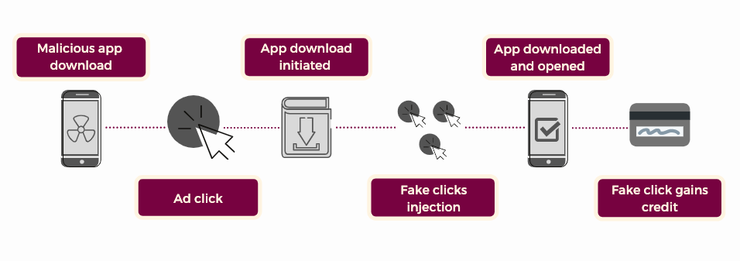
Ad Fraud Explained: How It Works and How to Avoid It
Has ad fraud ever affected your campaigns? You might even fail to notice that your advertising budget is being wasted on bot traffic. Fortunately, we know how to avoid it.
According to Integral Ad Science, $82 billion goes to fraudsters’ pockets every year in the US. And guess where this money comes from.
In this post, we’ll define ad fraud, list the most common ad fraud methods, and tell you what you can do to protect your budget.
- What is ad fraud?
- Ad fraud in native advertising
- Ad fraud techniques
- How to detect ad fraud
- How to prevent ad fraud
- Ad fraud detection tools
What is ad fraud?
Advertising fraud is a deliberate technique of driving fake activity, such as impressions and clicks, and preventing advertising campaigns from being seen by real people.
Most often, there are bots that carry out ad fraud – they generate fake clicks on ads and/or fake activity on a website that displays these ads. However, bot traffic isn’t the only technique applied by fraudsters. We’ll list ad fraud methods further in the article.
Ad fraud in native advertising
Any advertising campaign can become subject to ad fraud, and native ad campaigns are no exception.
DSPs have been largely criticized for the bad activity that is typical to ad exchanges where a long line of events happens before an ad gets displayed. Demand-side platforms deal with large volumes of data and media types of all formats, which makes it difficult for these platforms to predict and prevent fake activity.
As bots have evolved significantly over the past years, distinguishing bot and human behavior is a serious challenge for advertising platforms these days.
How native ad platforms combat ad fraud
To ensure advertisers and publishers don’t fall victim to malicious actions of cybercriminals, top-notch native ad platforms partner with ad fraud prevention companies or even develop their own anti-fraud technologies.
For instance, MGID’s anti-fraud system allows the platform to deliver 96% human traffic. To improve media quality, Revcontent partners with Protected Media, a global driver of advertising solutions to detect and prevent problematic traffic.
Voluum DSP has developed an anti-fraud kit that indicates suspicious clicks, visits, and fake conversions and gives advertisers all the data they need to block non-human traffic.
Outbrain doesn’t fall behind its competitors. ‘Providing a clean, non-fraudulent network for publishers, advertisers and readers is a top priority here at Outbrain. We proactively monitor our network to ensure this.
Outbrain detects fraudulent traffic by using both internal solutions and third party-solutions to identify and investigate domain spoofing issues and unusual traffic patterns across Outbrain’s network that do not conform to normal behavior.
We use AI and machine learning, and check metrics and indicators such as widget load parameters, traffic sources, time to click, IP address categorization and more.
We will continue to invest in solutions to thwart fraud incidents in the future,’ says Outbrain’s Haran Rosenzweig.
As for Taboola, the company announced the integration with IAS’s brand safety tools earlier this year. Now, advertisers can take full advantage of pre-bid blocking and post-bid monitoring pixels on Taboola campaigns, powered by IAS.
Ad fraud techniques
Ad fraud isn’t limited to click spamming. Here are the most common ad fraud methods that you need to be aware of.
1. Click fraud
You don’t need to be an expert in ad fraud to know what click fraud is. Cybercriminals drive lots of fake clicks on an ad, making a system think real users are interacting with it.
This technique isn’t necessarily applied by fraudsters but by your competitors or publishers whose websites your ads are served on. There are two ways fake clicks can be generated:
- Bot clicks. There’s a variety of bots used for ad fraud. Clicks faking is probably the most well-known practice. Bots click on your ads hundreds or thousands of times with the sole purpose of draining your funds without turning it into a profit.
- Click farms. These involve activities from low-paid employees who drive large volumes of clicks manually. As click farms are typically located in certain countries, such as India or Nepal, it’s quite easy to identify this type of ad fraud – an influx of clicks coming from these locations is most likely to be a sign of click fraud.
2. Click spamming
Click spamming is a common method applied to steal the credit for someone else’s attribution. Here tons of fake clicks are generated with the hope for the probability of misattribution. As most bidding systems optimize towards conversions, the number of fake conversions makes the placements look better, which results in higher CPCs being charged from advertisers.
3. Click injection
This is a more sophisticated form of click spamming. The key difference between these techniques is when clicks are generated.
This scheme can be implemented with the help of apps that users download unknowingly. Once they show the intent of downloading an app, fraudsters ‘inject’ a click that steals the credit for a download.
Here’s how click injection works:

4. Cookie stuffing
Cookie stuffing involves stuffing a user’s browser with multiple cookies without the user’s consent in order to steal credits for purchases happening from that browser.
Cookie stuffing is commonly used by affiliate marketers. An affiliate implements a cookie that misleads audience data and gets payout for clicks and conversions they haven’t generated.
5. Domain spoofing
IAS Insider defines domain spoofing as ‘a practice through which fraudsters pass off low-quality inventory as a high-quality or premium site.’
Advertisers pay higher bids to display their ads at premium websites, but instead, their advertisements get served next to unwanted content, in front of completely irrelevant audiences or bots. There are four ways of how advertisers can be tricked by domain spoofers:
- URL spoofing. Domain spoofers substitute the legitimate URL with the spoofed one during the auction. Cross-domain embedding. Let’s say, a fraudster has two sites: one with high traffic volumes but low-quality content (pornography, fake news, etc.) and another one with low traffic and totally brand-safe content. While pretending they’re displaying ads on quality sites with low traffic (and therefore, low earning potential for publishers), fraudsters will nest IFrames to serve the ads on sites with low-quality inventory.
- Malware. To apply this method, fraudsters need to bug user’s browsers with infected malware first. When a visitor comes to a premium site on a machine affected by malicious programs, ads will be injected into the page Publishers won’t get paid for clicks on these injected ads, as all the revenue is collected by fraudsters.
- Custom browsers. Bots use custom browsers to browse any site on the internet, copy the header information of premium legitimate sites, imitate their URL, and represent them to trick advertisers and ad exchanges.
On-Demand Video Course On Native Advertising
Boost your ROAS with native ads. Enroll now with our limited 30% discount.

Warning signs of ad fraud activity
Suspicious performance
Are some campaigns driving way more clicks and fewer conversions than the other ones? It doesn’t necessarily mean something is wrong with your campaign setup. Check placements your ads are served on – are there any sites delivering the largest number of engagements that hardly ever result in conversions? Block these placements and watch how your campaign performance is improving.
Unusual peaks of performance
Surges in impressions or clicks that aren’t related to recent changes in your campaigns might also be indicators of fake activities. Every chaotic peak should be carefully analyzed and addressed if you don’t want to lose your budget to fraudsters.
Poor user behavior
If your landing pages are flooded with bots, you can detect it by analyzing on-site behavior. Abnormally high bounce rates and extremely short dwell time might be sure signs of ad fraud.
Bots crawl websites faster than any human can do, so if you see that an average session doesn’t last longer than a few seconds, it’s most likely that your campaigns are driving bot traffic.
Low-quality sites
Double check sites your ads are served on. Yes, manually. As ad fraud methods are getting more and more sophisticated, it’s very likely that you might fail to recognize suspicious URLs. By examining your ad placements, you’ll ensure your ads don’t appear on low-quality websites.
How to prevent ad fraud?
Ad fraud poisons all the aspects of your advertising campaigns. To reach your marketing goals, ensure your budget is spent wisely, and protect your reputation, you need to be ready to detect and prevent ad fraud. Here are the key steps we recommend you to take so that you don’t get tricked by fraudsters.
Work with trusted platforms
Don’t want to waste your budget on fake activity? Then work only with trusted platforms.
Some advertisers don’t want to ‘overpay’ for premium inventory or make efforts to create campaigns that pass strict requirements of quality advertising platforms. Therefore, they partner with cheap but questionable networks, without even checking their domain portfolio. But there’s no free lunch. Low-cost traffic sources usually cost advertisers their campaign budget – instead of driving leads or sales, they eat up money and deliver irrelevant audiences or bot traffic.
Monitor your campaigns
We all understand the importance of monitoring campaign performance to identify issues in campaign setup and optimize for better results. However, you should also remember that arising problems might be caused by fraudulent activity, which can often be prevented by blacklisting suspicious IPs or domains.
Create blacklists
When you select unwanted placements or IPs, blacklist them on the account level. You don’t want to go through the same process every time you launch new campaigns, do you?
Set rules
Identifying deceiving techniques before they hurt your campaigns is the biggest challenge. Even though you might be checking performance reports on a daily basis, one hour of delay might be crucial.
Set up automated rules so that the system will be constantly checking key performance metrics and informing you promptly once underperforming elements are identified.
Implement anti-fraud technology
If you aren’t sure your ad platform leverages proper technologies for ad fraud prevention, you can implement an anti-fraud solution on your side.
Anti-fraud tools will detect and filter out bot traffic, identify malicious placements, and block advertiser’s impressions from appearing on these sites.
Ad fraud detection tools
By conducting manual checks, you can reduce the impact of ad fraud on your campaigns for some time, but you won’t eliminate it. To avoid more sophisticated ad fraud techniques, you might want to invest in the following software:
Mind that the more popular the company is the more chances fraudsters have learned to evade detection by this vendor. That’s why we recommend that you conduct an in-depth research before picking the tool that will be right for you and consider its features, not the brand name.
Whether you work with a top-notch ad platform or rely on a third-party solution, it’s always a good idea to keep an eye on what’s going on inside of your campaigns. Having a few levels of verification will give you all the necessary data for maintaining ‘healthy’ cost-effective campaigns.
Ready to run more effective native advertising campaigns? Joinative is here to help. With one of the following paTo help you make the most of native advertising, we offer 3 different packages:
- Native Starter. If you need a native advertising consultancy, this package is right for you – our experts will guide you through the processes of campaign creation, performance tracking, testing, and optimization so that you can run effective campaigns by yourself when the training is over.
- Native Managed. Looking for someone to run native ad campaigns for you? Our experts will take care of your campaigns and ensure your goals are met.
- Native Audit. What if you’ve already launched your first native ad campaigns and the results don’t meet your expectations? After reviewing your campaigns thoroughly, we’ll identify performance issues and suggest workable solutions that will maximize your native advertising ROI.

 Feed
Feed


